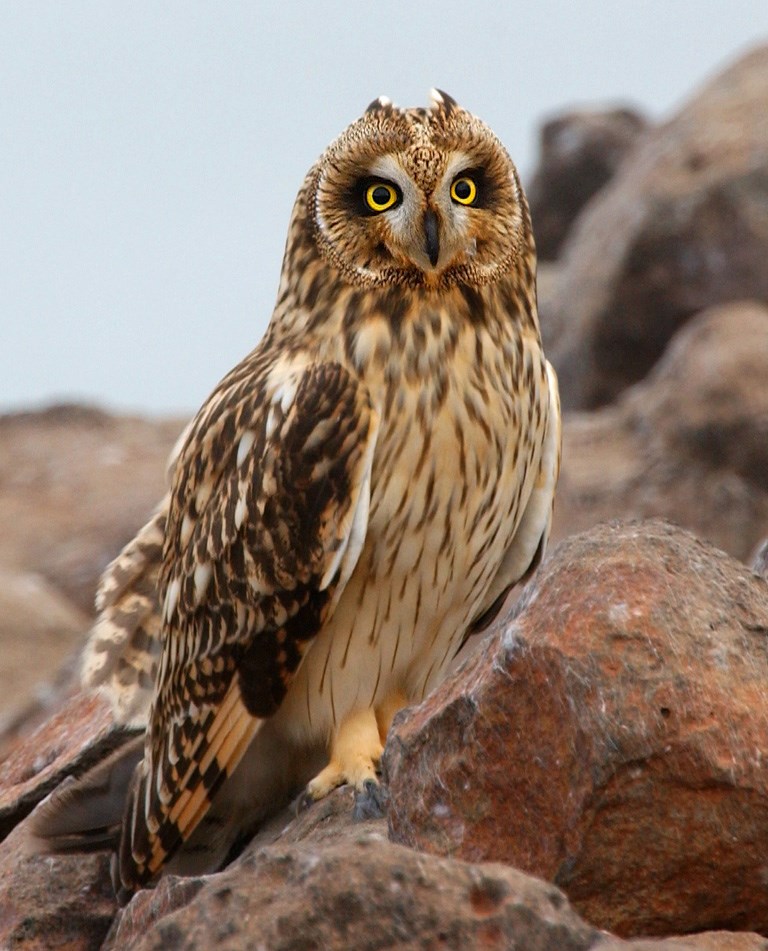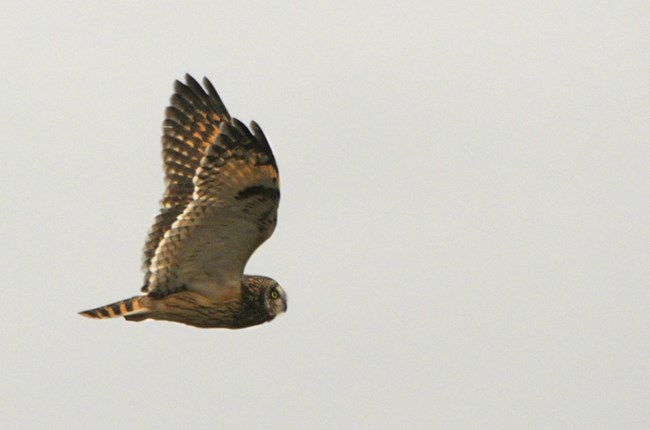Last updated: April 30, 2020
Article
Short-eared Owl

Jim Livaudais and Klamath Bird Observatory
General Description
An owl’s large head is all eyes, ears, and distinctive feathers covering the facial disc, with the eyes comprising up to 5% of bodyweight. “Indeed,” writes Paul Johnsgard, “the heads of owls are basically little more than brains with raptorial beaks and the largest possible eyes and ears attached.” Ears in owls are located on the sides of the head but some owls have “ear tufts” atop their heads that may function as display feathers or as camouflage. The ear tufts of the short-eared owl (Asio flammeus, family Strigidae) are inconspicuous until the owl becomes defensive or curious, at which point the whole facial expression changes: feathers around the nose may flatten and eyes narrow slightly. Their bright yellow eyes rimmed in black are striking in the pale facial disk. The scientific name, loosely translated to mean “fiery horned owl,” describes the streaked plumage on the pale underside, gorgeous to see at sunset, and the usually invisible ear tufts. Distinctive when in flight are the dark crescent-shaped carpal (“wrist”) marks on the underwing. Upperparts are mottled brown and buff.
At 35–43 cm (14–17 in) adults are barn owl size but with a longer wingspan of 86–102 cm (34–40 in). Females and males are similar in size and color, though females tend to be larger and darker.
Short-eared owls are a somewhat quiet species. The most common vocalization in both sexes is a wheezy bark-like kee-ow. Other sounds include screams, whines, hoots, and clucks.

Jim Livaudais and Klamath Bird Observatory
Habitat and Range
Other common names for the short-eared owl are grass owl, marsh owl, and prairie owl, all descriptive of the open country the species selects, habitat that includes low shrublands. “Shorties,” as the English like to call them, live on every continent except Antarctica and Australia. Worldwide 10–12 subspecies are recognized. In our area they are permanent residents but also nomadic, moving in relation to prey abundance. Their habitats overlap with another global species, the northern harrier, with which they compete for food.
Behavior and Diet
Short-eared owls are primarily crepuscular hunters, meaning they are most active near dawn and dusk. Their flight pattern is buoyant and irregular or wavering, sometimes hovering and gliding close to the ground or vegetation, listening and looking for suitable prey. When prey is abundant short-eared owls will hunt and roost communally. They often roost on the ground in dense vegetation, and will roost in trees during winter. Meadow voles and mice are the favored food choice. They will also eat other mammals and birds. Nestlings will eat insects.
Reproduction
One of the best times to spot a short-eared owl is in late winter at the beginning of the breeding season. A male launches his spectacular courtship flight by rising quickly into the air with strong, deep wingbeats. On both the ascent and descent, he intermittently hovers, soars, and claps his wings together. On descent he “sashays” his way to the female. Landing in his territory near her, he calls to her with hoots, and she answers with kee-ow kee-ow. He delivers a food gift, she eats, and copulation begins.
Unusual for an owl, short-eared owls are ground-nesters. The female excavates a shallow depression on raised ground, hidden in vegetation or not, and lines it with grass and feathers. She lays 4–14 eggs at 1–2 day intervals and incubates the eggs for 24–29 days. Young develop rapidly and may leave the nest at two weeks. Actual fledging occurs within a month of hatching.
Conservation
Recently, conservation assessments in western North America have provided some evidence that the short-eared owl may be in a rangewide, long term decline. The Western Asio Flammeus Landscape Study (WAfLS) is an eight-state program engaging citizen scientists to help assess populations of short-eared owls across the western United States during the breeding season, March to May. Data from this long-term study are aiding land managers and others in designing and implementing conservation strategies for short-eared owls. Threats include fence and vehicle collisions, habitat loss, and climate change.
Where to See
In Klamath Network parks, short-eared owls are residents at Lava Beds NM and may be spotted at Redwood NSP and Lassen Volcanic NP.
Learn More
Johnsgard, P. A. 1988. North American Owls: Biology and Natural History. Smithsonian Institution Press. Washington and London.
Download a pdf of this article.
Prepared by Kasey Rolih
NPS Klamath Inventory & Monitoring Network
Southern Oregon University
1250 Siskiyou Blvd
Ashland, OR 97520
Featured Creature Edition: April 2020
Thumbnail image credit: Jim Livaudais and Klamath Bird Observatory
